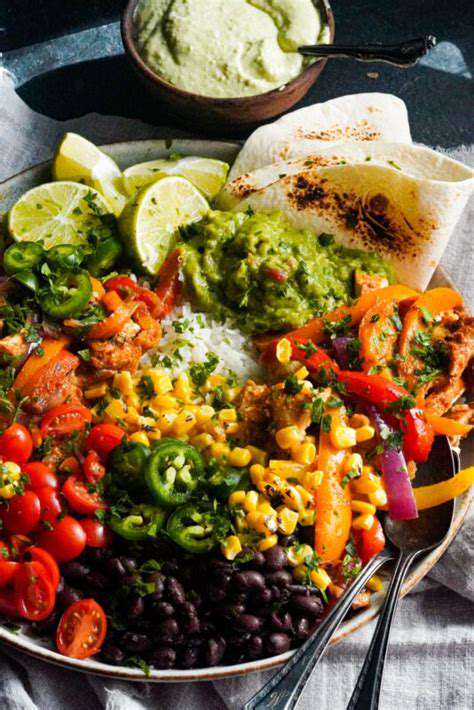Quick & Easy Chicken Fajitas: Weeknight Favorite
Mastering the Marinate
Marinating your chicken is crucial for flavor and tenderness in these speedy fajitas. A simple marinade of lime juice, olive oil, chili powder, cumin, garlic powder, and a pinch of salt and pepper will infuse the chicken with a vibrant and delicious flavor profile. Don't be afraid to experiment with different types of peppers, such as serrano or jalapeño, for a kick. For a gentler flavor, opt for a mild bell pepper. The longer the chicken marinates, the more flavorful it will become. Aim for at least 30 minutes, but up to overnight in the refrigerator for optimal results.
Properly marinating the chicken ensures that the flavors penetrate the meat, resulting in a more flavorful and tender final product. This crucial step allows the chicken to absorb the marinade's essence, enhancing its taste and texture. A well-marinated chicken will cook more evenly, leading to a more satisfying and enjoyable dining experience. So, take your time with this step, and you'll be rewarded with delicious fajitas.
Precision Cuts: Achieving Fajita Flair
Cutting the chicken into uniform strips is essential for ensuring even cooking and a visually appealing presentation. Use a sharp knife to slice the chicken against the grain into thin, consistent strips. This technique will result in tender, easily digestible chicken pieces. A meat mallet can also help tenderize the chicken, making the slicing process even easier. Consistent cuts also ensure that each piece cooks at the same rate, maximizing the flavor and texture throughout the dish.
Evenly sized pieces are important for a balanced cooking experience. If some pieces are thicker than others, the thicker pieces will take longer to cook, resulting in a less enjoyable meal. Strips that are too thick will be dry, while strips that are too thin may fall apart. Careful slicing and preparation are key to achieving the perfect fajita experience.
Speedy Cooking Techniques: Fajita Finesse
For quick and efficient cooking, use a large skillet or griddle over medium-high heat. Add a drizzle of olive oil to the hot pan and quickly sear the chicken strips on all sides until they are golden brown and cooked through. This ensures that the chicken is fully cooked while maintaining its moisture and tenderness. Add your preferred vegetables to the pan during the last few minutes of cooking to allow them to cook through and maintain their crisp texture. Cooking times will vary based on the thickness of the chicken and the vegetables.
To ensure that your fajitas are cooked evenly, stir the chicken and vegetables frequently. This will help them cook consistently and prevent burning. The cooking time will also depend on the type of vegetables you choose. For example, bell peppers will take longer to cook than onions. Keep a close eye on the cooking process to avoid overcooking the vegetables and ensure that they retain their desired texture. Cooking your vegetables until they are tender-crisp will enhance the flavor and texture of your fajitas.
Marinating Magic: Flavor Boost for Tender Chicken

Marinating Basics: Unveiling the Secrets
Marinades are more than just a quick flavor boost; they're a culinary alchemy, transforming bland ingredients into delicious masterpieces. Proper marinating allows the flavors of your chosen ingredients to meld together, creating a symphony of tastes that elevates your dish. Understanding the fundamental principles of marinating is key to unlocking this culinary magic.
Whether you're tenderizing tough cuts of meat or infusing vegetables with vibrant zest, a well-crafted marinade can significantly enhance the overall experience. The process isn't just about adding spices; it's about creating a chemical reaction that breaks down proteins and allows flavors to penetrate deeply.
Choosing the Right Marinades
The variety of marinades is as vast as the world of culinary creativity. From tangy citrus infusions to savory soy-based blends, each marinade offers unique flavor profiles. Consider the type of food you're marinating and the desired outcome when selecting your marinade.
Don't be afraid to experiment with different combinations of herbs, spices, and acids. The possibilities are endless, and the result can be a truly personalized culinary experience. Exploring diverse flavor profiles can lead to exciting new discoveries in your culinary journey.
The Importance of Acid
Acids play a crucial role in the marinating process. They help break down proteins, making the food more tender and allowing flavors to penetrate more effectively.
Vinegar, lemon juice, and citrus fruits are common choices, each contributing a unique tangy flavor to the final product. The acidic nature of these ingredients also helps to tenderize meats, making them more palatable and enjoyable.
Marinating Times and Temperatures
The duration of marinating time significantly impacts the final result. Longer marinating times allow for deeper flavor penetration and increased tenderness, especially with tougher cuts of meat.
Maintaining the correct temperature during marinating is also crucial. Cold marinades are generally preferred to prevent bacterial growth, while warm marinades can accelerate the flavor infusion process.
Marinating Techniques: Beyond the Basics
Beyond simply immersing ingredients in a marinade, different techniques can enhance the process. Vacuum sealing, for example, allows for more even flavor distribution and prevents the loss of precious juices.
Safety Considerations
Marinating involves handling food and ingredients that can potentially harbor harmful bacteria. Proper hygiene and safety measures are crucial to avoid foodborne illnesses. Ensure all ingredients are fresh and handled with care.
Always refrigerate marinades, and avoid leaving marinated foods at room temperature for extended periods. Following these guidelines ensures the safety and enjoyment of your culinary creations.
Maximizing Flavor Infusion
Proper preparation of ingredients before marinating can significantly impact the final flavor. Cutting meat into smaller pieces increases the surface area exposed to the marinade, allowing for faster and more thorough flavor absorption.
Consider the cooking method for your marinated food. Different cooking techniques may require adjustments to the marinade or cooking time. This will ensure the final dish retains the desired level of tenderness and flavor.

Tips for the Ultimate Fajita Experience

Marinating Matters
Proper marinating is crucial for flavorful fajitas. Don't underestimate the power of a good marinade! It's not just about flavor; it's about tenderizing the meat, allowing the flavors to penetrate deeply, and creating a truly mouthwatering experience. A marinade typically consists of acidic ingredients like lime juice or vinegar, which help break down the proteins, along with flavorful additions like garlic, onions, and spices.
Experiment with different marinade combinations. Try a blend of chili powder, cumin, oregano, and a touch of smoked paprika for a smoky, Southwestern flair. Consider adding a splash of orange juice or mango chutney for a vibrant twist.
Choosing the Right Protein
The choice of protein significantly impacts the overall fajita experience. While steak is a classic, chicken or shrimp offer lighter alternatives, making them suitable for those seeking healthier options. Consider the dietary needs and preferences of your guests when making your choice. For a vegetarian option, marinated portobello mushrooms or bell peppers can be a fantastic substitution.
Ensure your protein is properly seasoned before marinating. This will allow the flavors to meld seamlessly throughout the cooking process.
Mastering the Cut
Properly slicing your protein is essential for achieving perfectly cooked and easy-to-eat fajitas. A good cut ensures that the meat cooks evenly and retains its tenderness. Thinly sliced cuts will cook quickly and evenly, ensuring a desirable texture.
Using a sharp knife is essential for this process. A dull knife can result in uneven cuts, which can lead to uneven cooking.
The Art of Sizzling
High heat is key to achieving that restaurant-worthy fajita experience. A hot grill or griddle is essential for searing the protein quickly and creating a delicious crust. Cooking the fajita ingredients quickly over high heat will ensure they maintain their moisture and flavor. This technique locks in the juices and enhances the overall taste and texture.
Sides that Sparkle
Fajitas are incomplete without the perfect accompaniments. Consider a variety of colorful vegetables like bell peppers, onions, and mushrooms. These additions add depth to the flavor profile and provide essential nutrients. Don't forget the important role of fresh cilantro and a squeeze of lime to complete the flavors.
Perfecting the Presentation
Presentation plays a crucial part in enhancing the overall dining experience. Arranging the fajitas attractively on a platter can make all the difference. Consider using colorful serving dishes and garnishing with fresh herbs for a visual appeal. The presentation of the food should complement the flavors and textures. It's important to use high quality ingredients to ensure the dish is visually appealing.
Serving Suggestions
Serving your fajitas in warm tortillas is a must. Consider offering a variety of toppings like salsa, guacamole, sour cream, cheese, and shredded lettuce for your guests to create their ultimate custom fajitas. These toppings add a burst of flavors and textures, enhancing the overall culinary experience.
Don't be afraid to get creative with your fajita toppings. Try adding a drizzle of honey or a sprinkle of chili flakes for a unique flavor explosion.
- How to Store Avocados: Ripening and Storing
- Keto Desserts: Guilt Free Sweet Treats
- Discovering Korean BBQ: Essential Marinades and Grilling Tips
- Grilling Basics: Perfect Burgers Every Time
- Simple Beef Recipes: Versatile and Delicious
- Plant Based Diet for Beginners: Easy Transition Tips
- Budget Friendly Healthy Meals: Eating Well on a Dime
- Vegetarian Lunch Sandwiches: Creative and Delicious
- Simple Chicken Stir Fry: Quick and Healthy
- Vegetarian Breakfast Burritos: Hearty and Flavorful
- How to Store Berries: Keep Them Fresh
- Classic American Meatloaf: The Ultimate Comfort Food